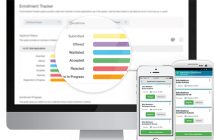
(Photo: AdamPrzezdziek, Creative Commons)
High school educators across the US are increasingly making use of social media to connect with students, and now some are looking to a popular new messaging app known as Snapchat to engage students and offer a new way to learn.
Snapchat allows its 100 million users around the world to send videos or pictures that disappear 10 seconds after the recipient opens it. According to the company, 60% of its users are between the ages of 13 and 24, with a separate estimate suggesting that 77% of college students use the app on a daily basis.
The company said that if parents and teachers are not familiar with how the app works, it was intentionally created to be that way.
“We’ve made it very hard for parents to embarrass their children,” Snapchat co-founder and CEO Evan Spiegel said at a conference this past January, reported Bloomberg Business. “It’s much more for sharing personal moments than it is about this public display.”
However, some are putting in the time to learn how to use the app. For example, adjunct professor Michael Britt at Marist College in upstate New York has put Snapchat videos into his introductory psychology course, taking “snaps” of real-life examples of his lectures and posting them to the app. He said he does this just before an exam in an effort to help students study, writes Nicole Gorman for Education World.
“The best way to learn new material is to try to personalize it to your life,” Britt says. “You know, come up with an example or attach it to some prior knowledge.”
He estimates close to 90% of his students make use of his Snapchats when they study, making it an easy way to give students a little more knowledge after they leave the classroom.
One of his former students, Selma Metwally, said the app helped increase her grade when she enrolled in the course last semester. She told Jacquie Lee of NPR that while it’s difficult to give your full attention to a professor during an 8 a.m. class, she found it easier to retain the information sent to her over Snapchat.
Not all teachers agree that the app is useful in the classroom. In North Carolina, Wake County public schools banned students from accessing the app with the school’s WiFi network in September after discovering that the app was not being used as a classroom resource. Lisa Luten, the district’s director of communication, said the block could be removed if teachers discovered an educational use for it, although she said that has yet to happen.
Meanwhile, some teachers do put the app to use but have been unsuccessful in their efforts. High School Spanish teacher Emily Huff has used the app in her classroom for the last three years in Denver, Iowa. Her students take a picture of something, label it in Snapchat and take a video of them saying the word. While Huff says its a quick and easy way to retain new vocabulary words, she adds that this could be part of the problem.
“It’s easier, but not as helpful as other options because you can be completely finished with that word in 15 seconds,” she says. “Vocab word retention isn’t as good with Snapchat as it is with other more rigorous options.”




